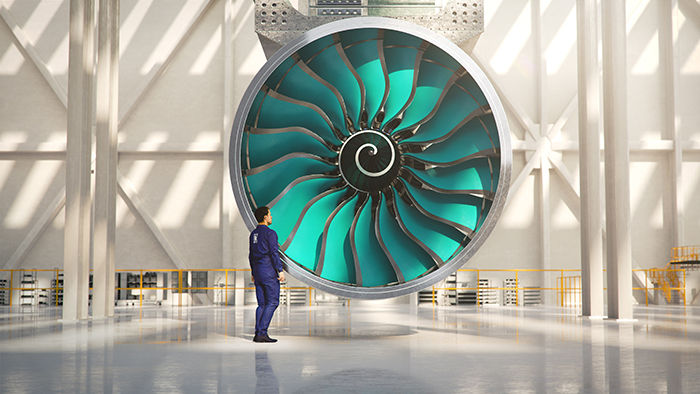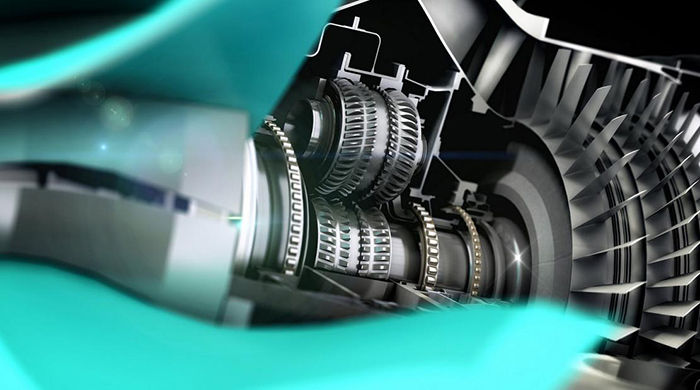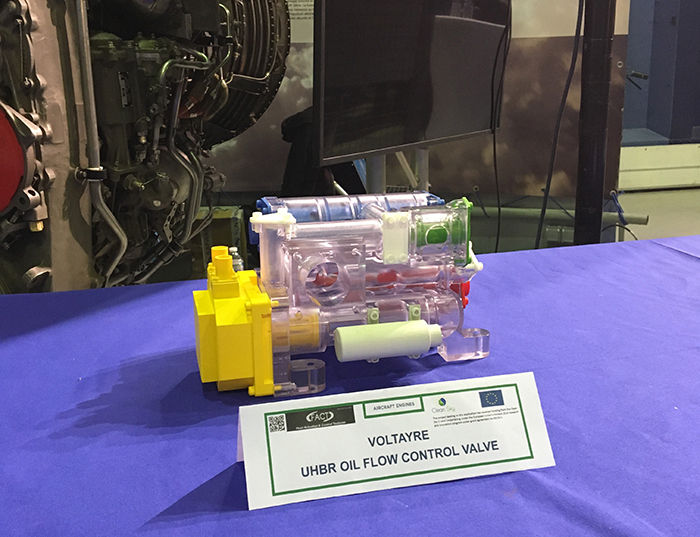‘It’s all coming together, and it gives me a real sense of pride to know that this program is about to deliver something tangible and something that will make a real difference in reducing emissions at a time when people are preparing to connect again, travel again and want to do so sustainably,’ says Charmain Cordo, chief project engineer, Rolls-Royce.
VOLTAYRE’S Oil Valve Improves Gearbox Performance
A key innovation in the UHPE engine is the introduction of a gearbox (a gear train between the blower and the rotor), which enables the engine input blower to run at a different speed to the main rotor. This allows an increase in the secondary air flow provided by the blower while improving the efficiency of the different compression stages.
VOLTAYRE is focused on the design and manufacture of an innovative high flow direct drive oil valve, which will be qualified to TRL 5 level. The valve will be able to meter accurately and split the flows coming from the pump to the gearbox and to the engine.
That’s where the Clean Sky VOLTAYRE (valves for oil regulation with high accuracy and reliability) project comes in. With the support of the European Commission’s Horizon 2020 funding, VOLTAYRE is focused on the design and manufacture of an innovative high flow direct drive oil valve, which will be qualified to TRL 5 level. The valve will be able to meter accurately and split the flows coming from the pump to the gearbox and to the engine, allowing the excess oil flow to return to the tank. The valve will also communicate a visualization of the delivered oil flows with the FADEC (full authority digital engine control).
The VOLTAYRE concept is based on the upsizing of a patented electronic free low energy limited angle torque motor developed by FACT (Fluid Actuation & Control Toulouse), an SME based in L’Union, France. The company has developed a torque motor which provides high torque, high displacement, high ageing stability, and without dynamic seals which is able to directly drive a spool that can meter and split an oil flow.
“Due to the large range of power, we need to reach a large range of oil flow,” says Sébastien Oriol, topic manager at Safran for the VOLTAYRE project. “It’s quite a new component because we have never done an oil flow measuring unit before.”
Clean Sky’s Integrated Intelligent Bearing Systems
Real-time monitoring of aero-engine bearings means that overhauls and repairs can be safely scheduled when they’re needed, as opposed to at fixed intervals determined by time or operation cycles. Clean Sky’s Integrated Intelligent Bearing Systems (I²BS) for the Ultra High Propulsive Efficiency (UHPE) Ground Test Demonstrator project is bringing a smarter approach to bearing health monitoring which will make European aero-engines more cost effective to operate while raising safety standards.
The idea of the Integrated Intelligent Bearing Systems (I²BS) for UHPE Ground Test Demo project is to design, develop, evaluate and test interchangeable conventional and smart bearings for the Ultra High Propulsive Efficiency (UHPE) Ground Test Demonstrator. The project kicked off in July 2016 and runs until December 2021.
Smart bearings will be able to deliver information related to their functional characteristics — their health, including temperature, axial and radial load, ball or roller or cage speed, lubrication quality, and radial clearance on each part of the bearing. And all of this information will be in real time, similar to Formula 1 racing cars, to see how they are working within the system.
Dr. Jean-François Brouckaert, team leader for Clean Sky’s Engine ITDs, references the context of the project by noting that “Safran’s UHPE demonstrator has a completely different engine architecture in terms of shaft support, bearing locations and shaft dynamics, because the weight balance along the shaft for an engine like this is very different from a classic direct drive turbofan, so there’s limited experience of what the bearings will have to endure in this new architecture. So, the concept is to have instrumented bearings to monitor it during the first test and to validate this with respect to the models, and the dynamics of the behavior of the engine in the longer term. If these smart bearings prove to be reliable, they could be used eventually for in-service health monitoring. But the project’s first goal is to understand the dynamics of the shaft on this concept.”
Patrick Mirring, head of product development aerospace at Schaeffler Aerospace (formerly FAG Aerospace) and coordinator of the project added, “In ideal conditions bearings last thousands of hours without problems, but that’s not the case inside an aircraft engine. For example, you could have contamination in the oil system, or oil interruption — if the oil pump isn’t supplying enough oil for the lubrication, you get friction which will lead to degradation of the bearing and eventually bearing failure.”
He continued, “With a smart bearing you will be able to detect any initial damage, so you’ll know exactly which component — whether it’s the outer ring or the inner ring or if it’s a rolling element — has suffered initial damage and consequently you’ll also have a prediction of the spall propagation behavior so that you’ll know the bearing’s remaining lifetime. And with this knowledge it will be possible to extend the overhaul interval.”
Currently the industry uses fixed overhaul inspections based on hours and/or cycles, but with smart bearings, by knowing how many hours of lifetime are left, it becomes possible to extend the inspection intervals and the maintenance intervals, potentially reducing overhaul costs. The project team is also carrying out estimations and calculations regarding the loading and speeding which are applied to the bearings.
“We don’t yet know how often overloading situations occur and therefore it could be that some of the bearings are over-engineered. With instrumentation on the bearings, we would get actual data from an engine to know what the maximum load applied is, how often it occurs and so on, and you can take this into consideration to design the bearing according to the real loading and speeding situation and therefore also downsize the bearings,” he added.
Clean, Green and Energy Efficient
Both the Clean Sky 1 and Clean Sky 2 projects came together in Europe to reduce emissions targets, significantly lower noise pollution and provide unparalleled fuel savings for the aerospace industry. R&D projects like this must start at the component level where bearings, gears, motors and drives can be ‘reimagined’ to provide a cleaner, more efficient roadmap to future aircraft production. These technologies can then be utilized in other areas such as automotive, industrial machinery, agriculture, mining, packaging, and marine applications. We look forward to the results of this research project across the globe.
www.cleansky.eu
Decarbonizing the Airport
Airports are at the forefront of leading the transition towards climate-neutral operations across the entire value chain. For example, the Airbus’ “Hydrogen Hub at Airports” concept brings together key airport ecosystem players to better understand hydrogen infrastructure needs for future aircraft and to develop a stepped approach to decarbonizing all airport-associated infrastructure using hydrogen.
The use of hydrogen to power future aircraft is not only expected to significantly reduce aircraft emissions in the air: it could also help decarbonize air transport activities on the ground. And the need to do so is certainly there. In fact, airport-controlled activities account for around 2-3% of the aviation industry’s total emissions. This represents approximately 15–20 megatons of CO₂ emissions per year globally.
For this reason, airports are now beginning to rethink how their infrastructures could be designed and operated to reduce their overall environmental footprint. One promising option is to build a unique airport ecosystem with hydrogen at the core of operations.
In 2020, Airbus launched “Hydrogen Hub at Airports’’ to help airports reflect on how to do just that. The concept aims to jumpstart research into infrastructure requirements for future hydrogen aircraft, as well as low-carbon airport operations, across the entire value chain. And a variety of airport authorities, airlines and energy providers are already signing on to get involved.
Airports are complex infrastructure assets that rely on deep interdependencies between multiple systems, structures and stakeholders. For example, ground transport at airports includes not only passenger transport to and from aircraft via buses, but also heavy-duty vehicles — such as aircraft tugs and cargo trucks — for logistics. Traditionally, these vehicles have been powered by fossil fuels, which contribute to airports’ overall emissions. But hydrogen could drastically cut the emissions of airport ground transport. In addition, airports require vast amounts of energy for cooling and heating, the environmental footprint of which could be mitigated through hydrogen.
The on-site production (and liquefaction) of hydrogen could also be a promising option for airports to meet their individual energy needs. This solution would eliminate the need for transport to and from off-site hydrogen production facilities, which would further reduce emissions. In doing so, airports could also become future energy ecosystems with liquid hydrogen production at their core.
“Airports have a key role to play to enable the transition to a climate-neutral air transport ecosystem,” says Lionel Cousseins, Airbus ZEROe Market Development and Airline Relations Manager. “Hydrogen Hub at Airports enables us to collaborate with partners to define needs today, so we can pave the way for hydrogen adoption by 2035.”
Partnerships across the airport ecosystem
To date, Airbus has activated Memorandums of Understanding (MoUs) with two airline customers to assess hydrogen infrastructure needs at airports. For example, an MoU with SAS Airlines is currently investigating airport infrastructure requirements for future hybrid, electric and hydrogen aircraft. A similar collaboration agreement was also signed with easyJet. The results of both studies are expected to be released later this year.
But airline partnerships are only just the beginning.
For hydrogen to meet its full potential, the entire airport ecosystem — airport authorities, energy suppliers, regulatory authorities — needs to come together to collaborate. To this end, Airbus has signed a joint-partnership with ADP (Paris Airports) and Air Liquide to better understand hydrogen infrastructure needs at Paris Charles-de-Gaulle Airport (CDG) and Paris Orly Airport (ORY).
“At Airbus, we see ourselves as a facilitator,” Lionel explains. “This means we want to bring together all the key players around the same table to ensure we have the necessary infrastructure in place to bring our zero-emission aircraft to market by 2035.”
Airbus expects to announce additional strategic partnerships with key players across the aviation ecosystem in markets worldwide throughout 2021.
www.airbus.com









